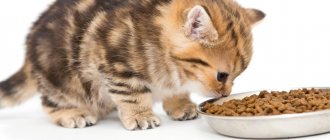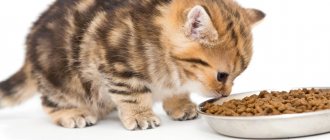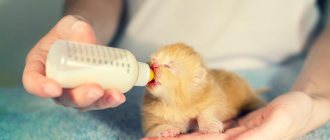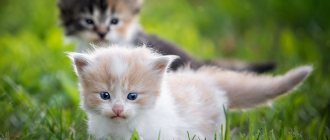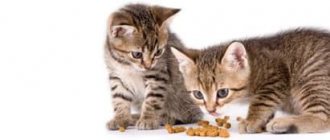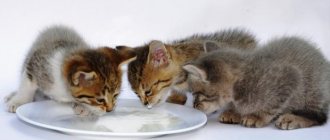By three months, your baby has already grown noticeably, certainly does not feed on his mother’s milk (the duration of lactation in a cat is about two months), and is quite ready to switch to adult food. Only the transition to a constant diet and a two-time feeding schedule must be carried out gradually, which will take about three months.
This period of a kitten’s life has its own characteristics, which must be taken into account when compiling its diet. He is already interested in everything that comes into view, and is not yet afraid of anything. This means that it moves a lot, climbs everywhere, it requires a huge amount of nutrients - after all, it also grows rapidly! You cannot limit a teenage kitten's food intake.
At about four months, teeth change begins. This process takes up to three months, although it can last up to eight months of age. For the most part, it does not cause inconvenience to either the animal or the owner. Moreover, owners do not always notice fallen teeth: they are very small, and kittens very often swallow them, which does not harm their health at all. Closer to six months, the pet should become familiar with many dishes of the adult diet.
Feeding a kitten up to 6 months - factory food or natural food?
Of course, now there is a large selection of food on sale, which is also designed for kittens almost from birth.
Both dry and wet diets are offered.
Yes, this option may well be preferable, but still, my personal opinion is that it is better to switch the kitten to a ready-made diet (especially a dry diet) starting from 6 months or older. I switched my Mars to dry food when he was 1.5 years old.
The digestive system of cats is quite sensitive and, in my opinion, switching a cat to dry food immediately after breast milk is not the best solution.
Wet food is a good alternative, but there are two important BUTs.
- Firstly, the cost of ready-made wet food (I mean, high-quality food) is very impressive. And even for a kitten, the expenses are considerable.
- Secondly, many wet foods are not complete, that is, their nutritional composition does not cover all the needs of a growing body. By the way, many manufacturers indicate this information on the packaging of such food (positioning it as an additional diet to dry food). Thus, the choice is narrowed.
Therefore, I believe that at the age of 2-6 months it is better to feed a kitten with natural food.
The importance of proper nutrition
If you have a small pet, you need to have an idea of how to properly and effectively feed a kitten in order to raise a healthy and happy animal.
The lack of a balanced diet affects the development and growth of the baby and can lead to physical disabilities, problems with internal organs and even death.
If the food is not selected correctly, this can lead to an allergic reaction in the young body, which can also affect the growth of the animal.
Feeding up to 3 months - features
It makes sense to separate the feeding age from 2 to 3 months into a separate chapter, since at this age the kitten can still receive mother's milk, formula, or cow's milk (if it is digestible).
If the kitten was weaned from its mother cat at 2 months, it makes sense to buy an adapted milk formula (especially for kittens) and dilute it in the required proportions according to the recommendations indicated on the label.
Honestly, when my cat was little, I didn’t even know about the existence of such mixtures, so I supplemented with regular cow’s milk (fortunately, he absorbed it well). As an alternative, you can use goat's milk.
Mars is 3 months old
If you have the opportunity to buy formula, I recommend feeding with formula for up to 3 months, since it is closest in composition to cat milk.
At 2.5 months, a kitten can be fed not only milk, but also begin to be accustomed to solid food.
So, the main diet is:
- Milk porridge with cereals - rice, rolled oats, barley porridge. Porridges should be liquid; you don’t need a lot of grains. Cereals contain B vitamins and are also a source of fiber and are more filling than just milk. For one serving of porridge, a level teaspoon of cereal is enough. It is better to grind the porridge until smooth, or purchase ready-made flakes, which you simply need to pour with milk or milk mixture. You can give the porridge to your kitten once a day.
- Vegetables and boiled meat. Mix boiled zucchini, cauliflower, broccoli, carrots with meat puree. You can prepare meat puree from lean meats (chicken, turkey, beef, rabbit) yourself or buy baby food in jars (without salt).
- Dairy products. Ryazhenka, Varenets, kefir - a little, 20-30 ml per day is enough. There is no need to feed the kitten sour cream - it is too fatty. A small amount of low-fat cottage cheese can also be given 2-3 times a week.
- Eggs. Boiled chicken or quail egg – once a week. Raw egg – once a week.
Important! Do not offer milk to your kitten as a drink. Milk is food. The kitten must have a separate bowl of clean water!
Approximate diet for one day in 2-3 months
A kitten's diet is quite monotonous in terms of variety of foods, so I will give an example of one day. Only the type of grains, vegetables and meat will change in the diet.
- The first feeding is formula or milk porridge.
- The second feeding is meat puree with vegetables, chopped or finely chopped.
- Third feeding – 30 ml of kefir.
- The fourth feeding is milk, formula or milk porridge (you can add a little meat puree to the mixture).
- The fifth feeding is meat puree with vegetables and low-fat meat broth.
What to feed a newborn kitten if he is left without a cat?
Previously, it was believed that kittens without mother's milk would die before they were one month old. Their body is not developed enough to accept cow's or goat's milk. And how, if the kitten has a developed sucking reflex, and he learns to lick only a month after birth.
Currently, in veterinary clinics you can buy a special mixture and a bottle for feeding small newborn animals. What to feed a newborn kitten if there is no clinic nearby? You can prepare the mixture yourself.
Mixture for newborn kittens : 10 ml low-fat cream, 4 ml glucose (sold at the pharmacy), 6 ml purified water (can be boiled). Chop.
Feeding a kitten
It is necessary to feed a kitten up to a month every 2 hours, give 2 ml of the mixture. If there is no feeding device, take a regular syringe without a needle. Drop it drop by drop while your baby sucks. After feeding, the kitten must be sent to the house from the blanket and the belly massaged like a cat so that the food is absorbed and the baby receives tactile contact to adapt to the outside world.
Feeding a kitten from 3 to 6 months
The first and most important rule in feeding a kitten starting from three months is the complete exclusion of milk from the diet! Kittens at the age of three months stop digesting lactose.
In general, I knew about this. But my kitten liked liquid milk porridge and I decided to gradually wean him off this dish.
But everything happened much faster. At exactly 3 months he stopped digesting milk. If just yesterday he ate milk and everything was perfectly digested, then on his three-month birthday after drinking milk, the cat instantly developed diarrhea and from that moment on he does not digest milk at all.
If your cat does not have this reaction, this does not mean you need to continue giving milk. Milk is difficult to digest and is simply not needed for kittens older than three months. It's time to change your diet. What else you should not feed cats, read here.
What should be in the diet of a 3-6 month old kitten:
- Fermented milk products (if digestible) in very small quantities 2-3 times a week. 20-30 ml – no more.
- Meat and boiled vegetables (you can also add cereals). Now meat should be given in pieces, and not just in the form of puree. The kitten should get used to gnawing food rather than licking it. Vegetables also need to be cut into small cubes. You can gradually increase the size of the pieces to large enough - by 6 months the kitten should be able to chew and eat a large piece of boiled meat (6-8 centimeters in length) and a whole small inflorescence of boiled broccoli without any problems. There should be more meat than vegetables. You can add 1/3 teaspoon of vegetable oil (sunflower, flaxseed, etc.) to the meat and vegetable mixture.
- Low-fat broth. Meat broth from boiled meat without salt can be mixed with vegetables and meat - my cat ate this soup with more pleasure than meat with vegetables without broth.
- Eggs and cottage cheese can be given once a week.
- Raw meat. From 4 months onwards, you can give your kitten a small amount of raw beef - useful for developing chewing skills, for preventing tartar and for developing hunting skills. Do not give your kitten raw poultry or pork. From raw meat, only beef can be given after freezing and subsequent defrosting. This type of meat is the safest. Again, raw meat should not be the mainstay of your diet. Moreover, if you plan to eventually transfer the kitten to feeding with factory food.
- Wet food. You can include wet kitten food in your diet as a treat. Pay attention to the composition - you need to choose high-quality food.
- Boiled sea fish - haddock, blue whiting, hake. It is better to feed fish no more than once every two weeks. Fatty fish should be excluded.
- Vegetable oil. 0.5 teaspoon per day. It is better to add oil to porridge or vegetables.
There should be more meat than vegetables and grains. For 50 grams of boiled meat, 15 grams of vegetables or cereals (ready-made) is enough.
Starting from 6 months, you can switch the kitten to factory food or continue to feed it natural food with some changes towards “adult” food.
Sample menu for a kitten 3-6 months old
- The first feeding is boiled meat with cauliflower (or other vegetables) and broth (medium cut).
- The second feeding is a raw egg (you need to be sure of the good quality of the eggs).
- The third feeding is meat with porridge in meat broth.
- The fourth feeding is boiled meat with zucchini and broth.
The second feeding can be alternated - fermented milk products, wet food, boiled egg, soft cottage cheese.
What to feed a kitten: reviews
Reviews about
feeding kittens:
Anna : We found a baby on the street, it wasn’t a month old yet. They fed them with a mixture of cream and glucose, and after a week they added milk, cottage cheese, and sour cream. A little later, vegetables, cereals and meat and fish. Now furry Vaska is already six months old since we found him. Gorgeous cat, and so affectionate! The vet checked and said he was completely healthy.
Maryana : We bought a kitten for the children and didn’t even expect that it would be such a responsibility! The seller wrote us instructions on what to feed and how, but we only got our bearings at home. My husband and I took turns waking up at night, and during the day we heated food in tiny portions every 3 hours. At first they weighed him, they were afraid that he was not eating enough. But then we got used to it, we add a little more. While he is young and active, he walks thin, but the doctor said that if he starts to gain weight, give him portions according to the weight formula.
In conclusion, we suggest taking a look at our other articles about kittens and adult cats:
- Is it possible to leave a cat alone for a day, 5 days, a week, two weeks?
- At what age is it better to take a kitten of different breeds home: advice from a veterinarian;
- I can’t cope with death, the loss of a cat: what should I do?
- The cat abandoned the kittens and does not want to feed them. How and what to feed newborn kittens?
- How to cut a cat's hair at home? Cat haircuts: photos;
- Why does a cat breathe like a dog, sticking out its tongue?;
- Scottish Fold cat: character, features, description of the breed
Portion volume
Because our furry friends grow so quickly, we can't always determine the optimal amount of food to offer them. Kittens that get full and move away from the bowl that still has food in it will be less of a hassle. But you might be lucky enough to meet a real glutton who will eat everything he sees! The recommendations of experts in this case are very simple: it is better to underfeed a little than to overfeed a little, because the second option is guaranteed to cause digestive problems. The best way is to pick up your pet and feel his tummy: it should look round, but not bloated. At the same time, the baby should not show concern, but, on the contrary, having eaten tasty and enough, he will definitely confirm this with a grateful purr!
Vitamins and supplements
When kept on high-quality, industrial feed, vitamins and additives are not required. It is important to understand that an excess of vitamins and microelements is no less dangerous than their deficiency. With a natural feeding method, vitamin supplements should be present in the diet on an ongoing basis at least until the age of one year.
A kitten can get basic vitamins and nutrients from natural products:
- Meat and bone meal.
- Fish, chicken, beef liver.
- Greens, vegetables, fruits.
- Sunflower oil, olive oil.
- Brewer's yeast.


